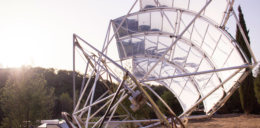“Ultralight Membrane Mirror”
Breakthrough for Solar Cooking & Community-Scale Industrial Processes
Dr. Douglas Baillie, January 31 2018

Over the past three years in the Solar Test Field, we’ve dedicated ourselves to the development of a very interesting technology: using thin stretched polymer membranes to create a high precision solar concentrator for various decentralized solar applications.
In brief, our prototype mirror uses 0.1mm thick reflective polymer films inflated with air pressure over a lightweight aluminium frame, achieving high optical precision cheaply and with very low embodied energy. It has an effective optical aperture of ~4m2, concentration of over 1000 times, can heat to over 1000 degrees Celsius, and has applications ranging from round-the-clock cooking with storage, through to ceramics, metalwork and lime-burning for waterproof clay buildings, to photocatalytic fuel production.
We have achieved our major goal by completing the prototype mirror, and we celebrated this milestone in October 2017 here in Tamera with our cooperation partners from India and Australia, our mentor, German physicist Juergen Kleinwaechter – the inventor of the mirror – and other invited guests. A brief report from independent filmmaker “Daywalker” can be found here:
Last week, we presented our work to much acclaim from an international audience at the conference CONSOLFOOD 2018, in Faro, Portugal. In the words of one renowned solar entrepreneur, with vast experience in innovation and installation, “What you have in your hands can change the world. It is the next generation of the work that we have been doing for decades. Just seeing your work presented already makes the conference worthwhile for me.” This recognition from other experts in the field is understandable: the mirror combines high efficiency with minimal material requirements and therefore has the possibility to become a mass-produced economical workhorse for various applications such as around-the-clock cooking and operating as a decentralized multi-functional power source.
We left the conference not only with appreciation for our work, but also with concrete proposals for further cooperation in developing the prototype to market-readiness.
The knowledge and certainty gained by working with the technology and seeing it functioning – melting metal, cooking for 15 people long after sunset, resisting wind and rain – confirms the importance of creating a working demonstration model of the mirror. The next stage of development will come not so much from Tamera, but from our cooperation partners with whom we are engaging in technology transfer. Our small group with limited resources has managed to demonstrate a working prototype of membrane mirror technology. But to continue the work to the point where the technology is accessible takes a different scale of engineering and financial resources. Our task now lies in working with our emerging partners, transferring our knowledge and understanding and letting the project become independent, so that it can make a difference to the world, reducing deforestation and contributing to a future of decentralized solar energy.
Heartfelt thanks to our cooperation partners:
- Murad Futehally of Transweigh International, India, for his financial support (particularly at the start of the project), his integrity throughout and for his ongoing commitment as a development partner, taking on the next stage of development from prototype to product.
- Klaus Langer, Latronics, Australia, for supporting us to complete the project. Thanks also for his exemplary commitment to his word and for acting from the heart.
We would also like to express our appreciation to Patrick Hester, founder of Lamina Dielectrics, UK for his generous support in providing the polymer tubing used on the prototype. This was a welcome gesture of solidarity that made our work significantly easier.

